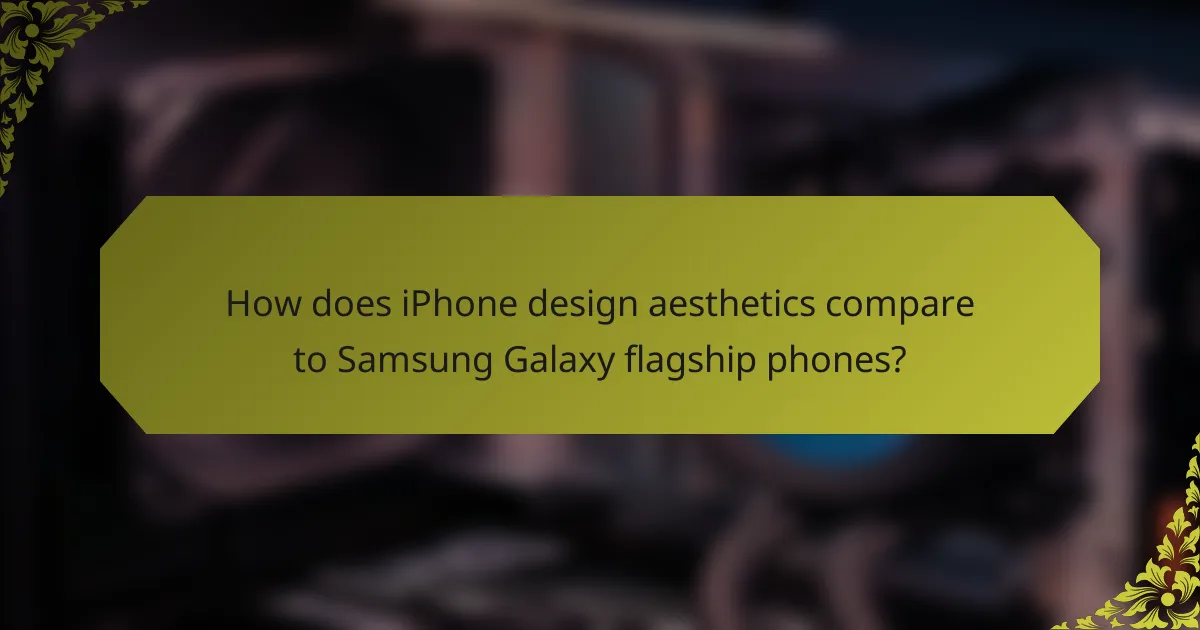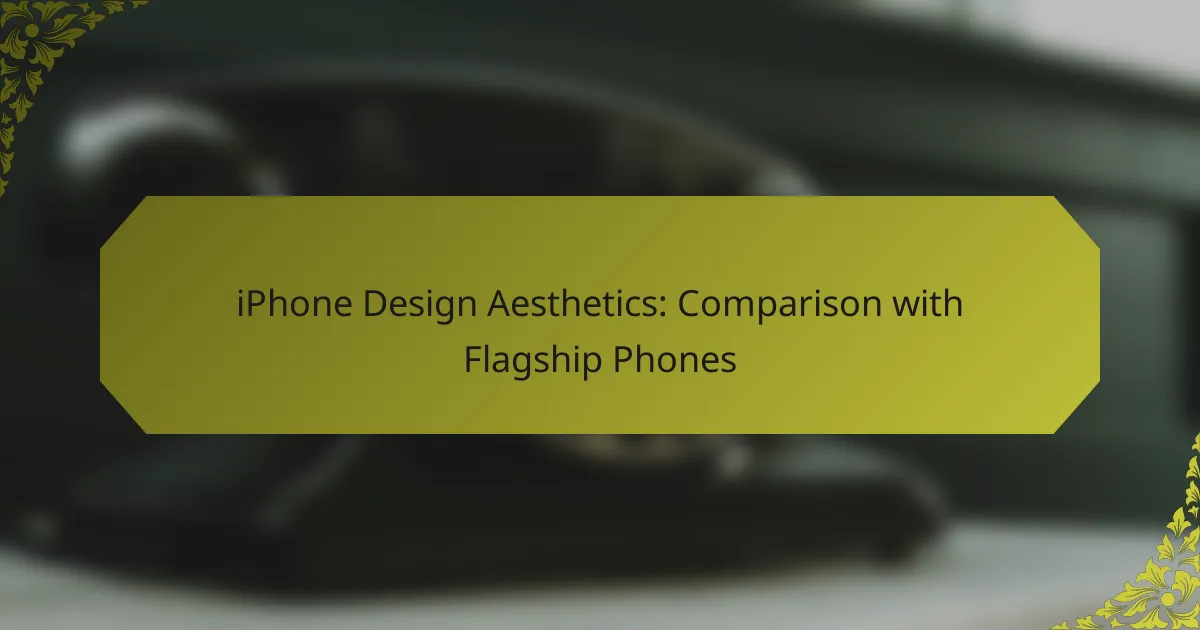The design aesthetics of iPhones and flagship Samsung Galaxy phones present a fascinating contrast, each embodying distinct brand philosophies. While iPhones prioritize minimalism and high-quality materials, Samsung embraces vibrant colors and cutting-edge features, appealing to different consumer preferences. This divergence in design not only influences visual appeal but also enhances user experience through thoughtful functionality and intuitive interfaces.

How does iPhone design aesthetics compare to Samsung Galaxy flagship phones?
The design aesthetics of iPhones and Samsung Galaxy flagship phones differ significantly, reflecting their unique brand identities. iPhones tend to emphasize minimalism and premium materials, while Samsung often showcases bold colors and innovative features.
Material quality and finish
iPhones are known for their high-quality materials, typically featuring aluminum and glass that provide a sleek and premium feel. The finish is often smooth and polished, contributing to a luxurious appearance.
In contrast, Samsung Galaxy flagship phones frequently use a combination of glass and metal, with some models incorporating ceramic. This results in a more dynamic look, with reflective surfaces that can enhance visual appeal but may also be more prone to fingerprints.
Color options and customization
Apple offers a limited but carefully curated range of colors for iPhones, focusing on classic and sophisticated shades like silver, space gray, and gold. Newer models may introduce seasonal colors, but customization options remain relatively restrained.
Samsung, on the other hand, provides a broader spectrum of color choices, including vibrant hues and unique finishes. This allows users to express their personal style more freely, with options that range from understated to eye-catching.
Ergonomics and user comfort
The ergonomic design of iPhones is tailored for comfort, with rounded edges and a balanced weight distribution that makes them easy to hold for extended periods. This design philosophy prioritizes user experience, especially for tasks like texting or browsing.
Samsung Galaxy flagship phones also focus on ergonomics, often featuring curved displays that enhance grip and reduce bezel size. However, the larger models may be bulkier, which can affect comfort for users with smaller hands.

What are the key design features of the latest iPhone models?
The latest iPhone models showcase a blend of sleek aesthetics and functional design features that enhance user experience. Key aspects include refined camera placements, optimized screen-to-body ratios, and intuitive button layouts that cater to modern usage patterns.
Camera placement and design
The camera placement on the latest iPhone models is strategically designed to minimize obstruction and maximize usability. Typically located in the upper left corner on the back, the camera module features multiple lenses arranged in a compact layout, allowing for advanced photography capabilities.
For example, the latest models often include a wide, ultra-wide, and telephoto lens, enhancing versatility. Users should consider how this arrangement affects grip and handling, especially when taking photos at different angles.
Screen-to-body ratio
The screen-to-body ratio in the latest iPhones is among the highest in the smartphone market, often exceeding 85%. This design maximizes display area while minimizing bezels, providing an immersive viewing experience for videos and apps.
A higher screen-to-body ratio means more screen real estate without increasing the overall size of the device. When comparing with flagship phones from other brands, look for ratios above 80% for a similar immersive experience.
Button placement and functionality
Button placement on the latest iPhone models is designed for ease of access and functionality. The power button is typically located on the right side, while volume buttons are on the left, allowing for quick adjustments without needing to unlock the phone.
Additionally, the latest models often feature tactile feedback and responsive designs, enhancing user interaction. Users should familiarize themselves with button functions, such as quick press for camera access or long press for Siri, to maximize their efficiency.

How do iPhone design aesthetics influence user experience?
iPhone design aesthetics significantly enhance user experience by creating an intuitive interface and fostering emotional connections with users. The sleek, minimalist design not only attracts users but also facilitates ease of use, making interactions seamless and enjoyable.
Intuitive navigation and usability
The iPhone’s design emphasizes intuitive navigation, which is crucial for user satisfaction. Features like the home screen layout, gesture controls, and consistent iconography allow users to navigate effortlessly. This design approach minimizes the learning curve, enabling even new users to become proficient quickly.
For instance, the use of large touch targets and clear visual hierarchies helps users understand where to tap and what actions to take. This is particularly beneficial for users with varying levels of tech-savviness, ensuring that everyone can access the device’s full potential without frustration.
Visual appeal and brand perception
Visual appeal plays a vital role in shaping brand perception, and Apple’s design philosophy is a key factor in its success. The iPhone’s elegant aesthetics, characterized by premium materials and a cohesive color palette, create a sense of luxury and desirability. This perception often translates into customer loyalty and a willingness to pay a premium price.
Moreover, the consistent design language across Apple products reinforces brand identity, making it instantly recognizable. Users often associate the iPhone’s design with innovation and quality, which can influence their purchasing decisions and overall satisfaction with the brand.

What are the design trends in flagship smartphones for 2023?
In 2023, flagship smartphones are characterized by innovative designs that prioritize functionality and sustainability. Key trends include foldable designs that enhance screen real estate and the use of eco-friendly materials that appeal to environmentally conscious consumers.
Foldable designs and innovations
Foldable smartphones are gaining traction as manufacturers explore ways to maximize display size without increasing the device’s footprint. These devices typically feature flexible screens that allow them to transform from a compact phone into a tablet, providing versatility for users.
However, foldable designs come with trade-offs, such as durability concerns and higher price points. Consumers should consider the potential for wear and tear on the hinge mechanism and the screen, which may not be as resilient as traditional designs.
Eco-friendly materials
In response to growing environmental awareness, many flagship smartphones are now incorporating eco-friendly materials into their designs. This includes the use of recycled plastics, biodegradable components, and sustainable sourcing practices that reduce the carbon footprint of production.
Brands are increasingly transparent about their material choices, often highlighting certifications and eco-labels. Consumers looking for sustainable options should check for these indicators and consider the long-term benefits of choosing devices that prioritize environmental responsibility.

How do iPhone aesthetics impact resale value?
The aesthetics of an iPhone significantly influence its resale value, as consumers often prioritize design when purchasing used devices. A well-designed iPhone tends to maintain higher demand, which can lead to better resale prices compared to less visually appealing flagship phones.
Brand loyalty and market demand
iPhone users often exhibit strong brand loyalty, which directly affects market demand. This loyalty can lead to a more robust resale market, as many buyers specifically seek out iPhones due to their reputation for quality and design. Consequently, iPhones generally retain their value better than many competing flagship models.
For example, an iPhone may sell for 60-80% of its original price after a year, while some Android flagship phones might only fetch 40-60%. This difference highlights the impact of brand loyalty on resale values.
Condition and appearance factors
The condition and appearance of an iPhone play critical roles in determining its resale value. Devices that show minimal wear, such as scratches or dents, are more likely to attract buyers and command higher prices. Keeping the phone in a case and using screen protectors can help maintain its aesthetic appeal.
Additionally, color and model variations can influence resale value. Limited edition colors or newer models typically fetch higher prices than standard versions. Sellers should consider these factors when preparing their device for resale to maximize value.

What emerging design trends should consumers watch for?
Consumers should pay attention to the integration of augmented reality (AR) features and personalization through software updates in flagship phones. These trends are shaping how devices interact with users and their environments, enhancing functionality and user experience.
Integration of AR features
The integration of AR features in smartphones is becoming increasingly prevalent, allowing users to interact with digital content in real-world settings. For instance, flagship phones are now equipped with advanced sensors and cameras that support AR applications, enabling experiences like virtual try-ons for clothing or makeup.
When considering AR capabilities, look for devices that offer high-resolution displays and robust processing power, as these factors significantly enhance the AR experience. Brands like Apple and Google are leading the way, often incorporating ARKit and ARCore technologies, respectively, which provide developers with tools to create immersive applications.
Personalization through software updates
Personalization through software updates is another key trend, allowing consumers to tailor their devices to better suit their preferences. Manufacturers are increasingly rolling out updates that enhance user interfaces, introduce new features, and improve overall performance, often based on user feedback.
To take advantage of this trend, ensure your device is set to receive automatic updates. This way, you can benefit from the latest features and improvements without needing to purchase new hardware. Additionally, explore customization options available in the settings to further personalize your experience, such as adjusting themes or app layouts.
